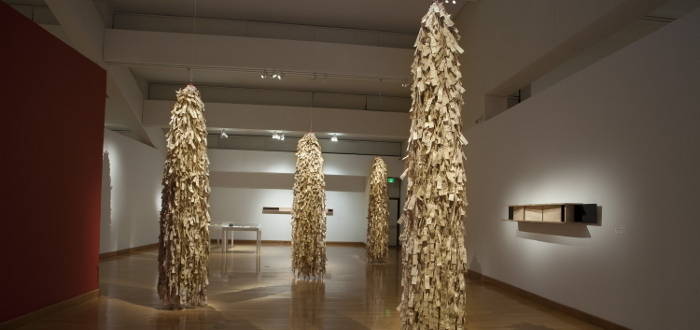When Wendy Maruyama collected names of the 120,000 Japanese Americans forced into concentration camps during World War II, she wrote them on paper tags and assembled them into 10 tree-like cascades. Ten marked the number of government-run camps. The sobering art exhibit was meant to stand alone, a reminder of the human toll of the nation’s military-enforced xenophobia.
Yet since its inception in 2009, The Tag Project, a traveling installation on display through this month at the San Jose Institute of Contemporary Art, has taken on new dimensions.
From a purely visual experience that conveys the profound impact of the mass evacuation of Japanese Americans in 1942, the piece became performative by adding sound. Against the backdrop of those age-yellowed tags, a poet speaks about lives postponed and forced relocation into internment camps. She recites names of the incarcerated over music, slow and somber. This Thursday, the exhibit takes on yet another component, one of physical movement.
“By dancing around these tags, we bring more life to the story,” says Jill Togawa of Purple Moon Dance Company. “The motion, and seeing these performers interact with the objects, adds a depth of feeling.”
In choreographing the dance to accompany the exhibit, she treated the ceiling-suspended tag displays as characters in a play. Dancers clad in period outfits—tweed pants or ankle-length wool dresses—brush up against them and spin the tag clusters. The rustle of paper becomes another element to the soundtrack. The spatial alignment shifts.
“I have found it a different challenge to work through,” Togawa says. “I love the sounds of the tags, the movement of the tags, and the stoic silence of them too. They represent for me, witness, totem—sometimes a stake marking the place—and countless individual voices.”
The comprehensive performance, titled When Dreams Are Interrupted, premiered in Berkeley in 2009 and has since traveled across California. This year, it touches down in the state’s few remaining Japantowns in Los Angeles, San Francisco and–for the first time this week for American Heritage Month and Memorial Day weekend–San Jose.
In each community, the experience changes. A poet adds local stories collected from the annals of this shameful chapter in American history. They read names of people from the community who were imprisoned. They share pieces of their stories.
Accompanying the tag displays, albeit in a separate venue, is another exhibit: “Executive Order 9066: Memories and Artifacts,” presented at the Japanese American Museum of San Jose. The display includes photographs and artifacts that show what people held on to when a presidential order culled them into relocation camps, what it was like to live inside them and what it was like to resettle after a life interrupted.
“My mother cleaned other people’s houses,” the poet says in the Maruyama-Togawa production. “My father quit farming and I threw away my scholarship application. We were housed with other families in a local church for months. I met old acquaintances on the street and they looked the other way. The neighborhood had changed.”

 FanimeCon 2014 Celebrates 20th Anniversary with Everything Anime
FanimeCon 2014 Celebrates 20th Anniversary with Everything Anime  Vesta's Pizzas Balance Novelty and Flavor
Vesta's Pizzas Balance Novelty and Flavor 


